George Bye, founder and head of Bye Aerospace, introduced the Silent Falcon unmanned aerial vehicle earlier this year at the Association for Unmanned Vehicle Systems International (AUVSI) meeting. He has two other relatively low-cost but highly capable offerings which could stretch the limits of unmanned aerial system (UAS) capabilities.
The first, the Starlight program, involves lifting a variable geometry, solar-powered airplane to great heights with a balloon, hovering with it for up to four months, and releasing it when needed to allow refurbishing, refitting and relaunching.
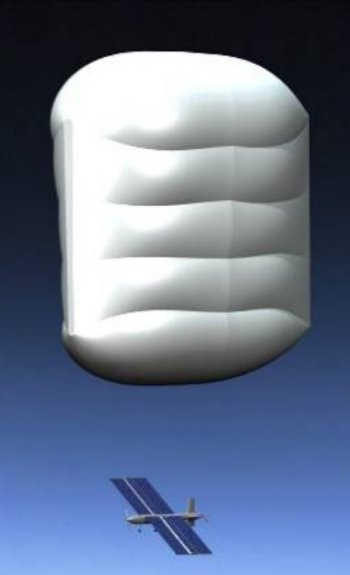
Bye Starlight solar-powered aircraft pulled aloft by large balloon in interesting hybrid arrangement
This two-stage system provides the same kind of surveillance offered by a satellite, but at a much lower cost. The balloon is a static device, used only to provide the altitude necessary, and the aircraft needs to provide power sufficient to allow station keeping and run its sensor systems for the period it is at altitude. When launched, the nose and tail-mounted electric motors power the airplane on its way. It can slide its wing panels along a track in the fuselage, reducing area to one high-aspect ratio panel for speed, or expand wing area to three panel width, or chord, slowing the craft but gathering more solar energy to run motors and sensors.
When attached to the airship, the solar panels can articulate up to +/- 50 degrees to optimize solar collection. The motors are also articulated, and can pivot up to 30 degrees to enhance station keeping.
Bye acts as a subcontractor to Global Near Space Services (GNSS) for the aircraft part of the Starlight system, designated a “stratospheric recovery vehicle” or SRV detachable UAS. This is all part of a U. S. Navy research contract to GNSS.
Phase 1 of Bye’s effort completed conceptual design and “systems trade studies” in 2010. Phase 2 includes detail design of the aircraft and design and assembly of a 40-percent scale SRV test vehicle.
Bye lists the following specifications:
- 25.6 feet wingspan
- 27.8 feet length
- 854 pounds gross weight
- 5 g limit load with 1.4 safety factor
- Thin-film photovoltaics for solar energy collection (probably supplied by partner Ascent Solar).
- Light-weight Li-ion batteries for energy storage
- Limited redundancy autopilot
- Test payload up to 50 pounds and 100 Watts of power
- Test altitudes from under 15,000 feet and reaching operational altitudes to 65,000 feet
Scaling things up to the anticipated 100-percent, the airplane would have a wingspan of 64 feet, and a length of 69.5 feet. Weight would be well over one ton.
The self-sufficiency and persistence of Starlight will probably make it useful to the military, but it has civilian purposes, too, in observing climate effects, droughts, wildfires, and even wildlife migrations. It can be used as a communications platform and provide a higher level of air traffic control with direct observation of situations.
A second offering from Bye Aerospace, the Silent Guardian Solar-Electric Hybrid Remote Piloted Aircraft (SEH-RPA) uses a Williams International turbofan engine to launch and climb to high altitude, and solar-electric power to loiter at its surveillance level. At that height, the turbine shuts down and thin-film solar cells power the small electric motors on the tips of the wings and the V-tail. Asked about the apparent small size of the motors and multi-bladed propellers, George Bye referred to the cleanliness of the design, and without providing a hard number, explained that even a 20:1 lift-to-drag ratio would generate only 200 pounds drag on the 4,000 pound airplane. (4,000 pounds is the fuel weight of the Predator B, by comparison.) If each motor produced 50 pounds of thrust, the airplane could maintain level flight all day, and into the night on battery power. Several model aircraft motors can produce 50 to 100 pounds thrust with less advanced propellers.
Acording to Bye Aerospace, “Potential government applications include border patrol and homeland security, search and rescue, visual and thermal reconnaissance and forward air control. Potential civil applications include traffic control, pipeline and power line inspection, aerial law enforcement, forest fire detection, weather monitoring and aerial photography.”
Both the Starlight and Guardian platforms are relatively inexpensive means to accomplish multiple missions. In an era of downsized military and civilian budgets, this might generate great interest.

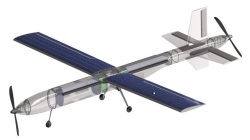
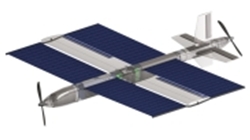
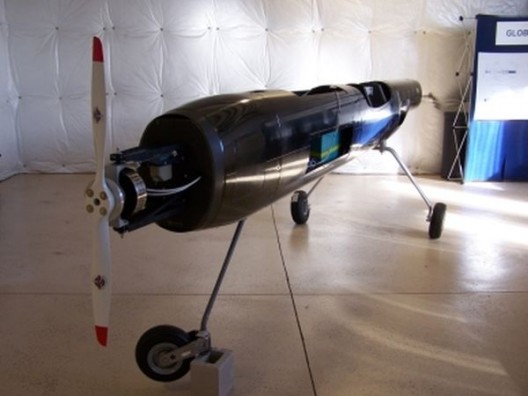
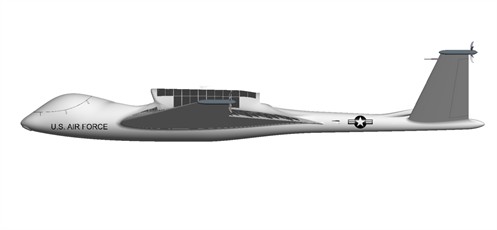
Comments 2
When is the next CAFE conference?
Yes, even tiny motors can generate 50 pounds of thrust – at sea level and zero airspeed. Doing so at high altitude with thin air and corresponding high speed would require much more power (force X speed) and correspondingly larger propellers. And makes it harder to supply from limited solar cell area.
That such a technical gaffe is tossed out so lightly by a key proponent makes me dubious of his claims. The aerodynamic inefficiency of violating an airfoil as he proposes for the first design doesn’t help either.
Best of luck but I’m not holding my breath…